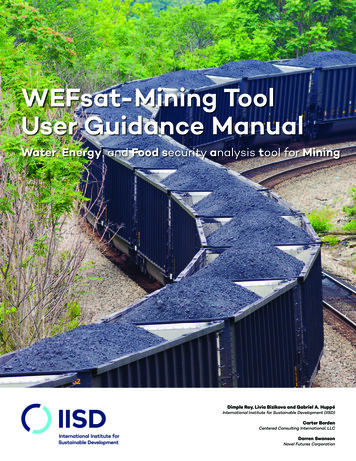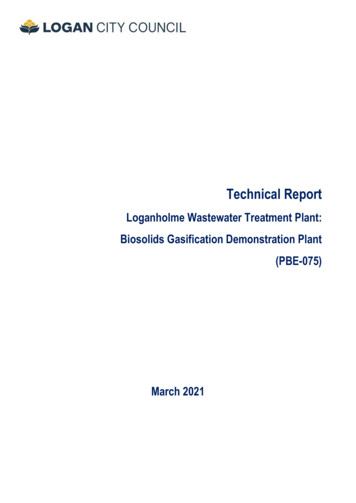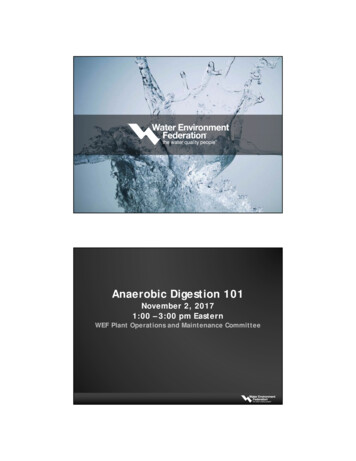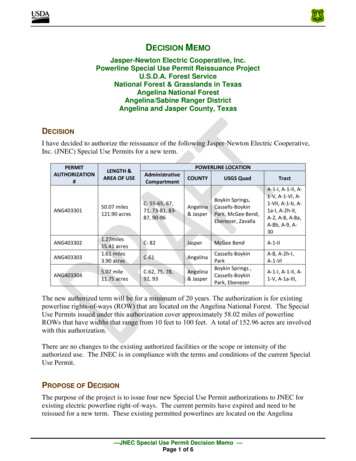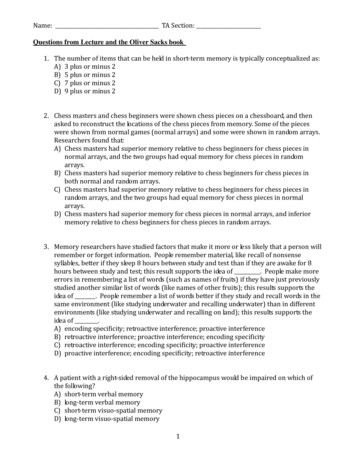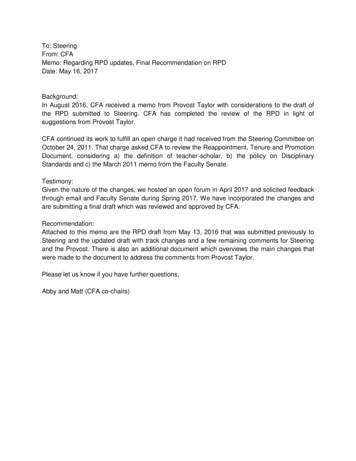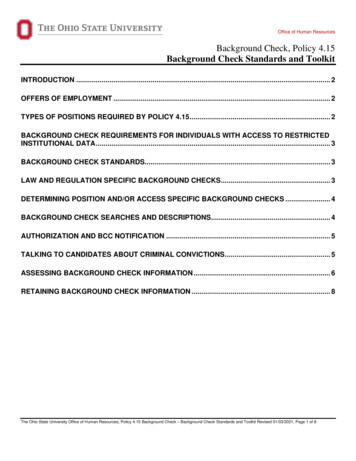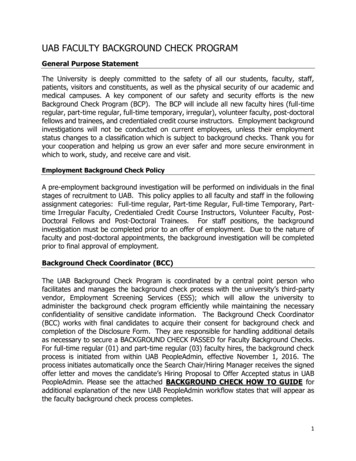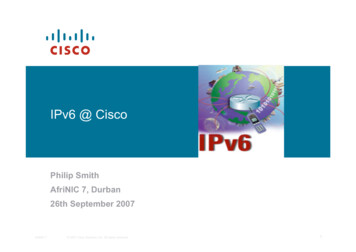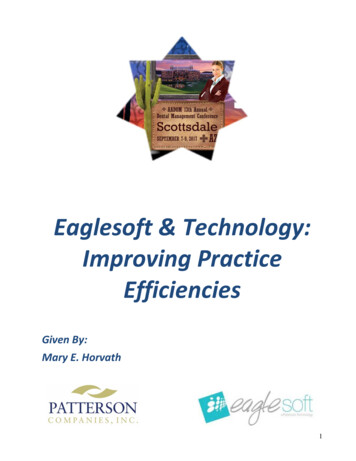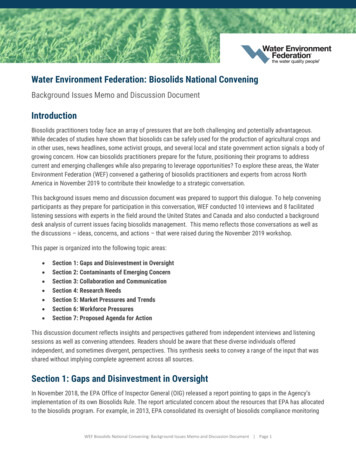
Transcription
Water Environment Federation: Biosolids National ConveningBackground Issues Memo and Discussion DocumentIntroductionBiosolids practitioners today face an array of pressures that are both challenging and potentially advantageous.While decades of studies have shown that biosolids can be safely used for the production of agricultural crops andin other uses, news headlines, some activist groups, and several local and state government action signals a body ofgrowing concern. How can biosolids practitioners prepare for the future, positioning their programs to addresscurrent and emerging challenges while also preparing to leverage opportunities? To explore these areas, the WaterEnvironment Federation (WEF) convened a gathering of biosolids practitioners and experts from across NorthAmerica in November 2019 to contribute their knowledge to a strategic conversation.This background issues memo and discussion document was prepared to support this dialogue. To help conveningparticipants as they prepare for participation in this conversation, WEF conducted 10 interviews and 8 facilitatedlistening sessions with experts in the field around the United States and Canada and also conducted a backgrounddesk analysis of current issues facing biosolids management. This memo reflects those conversations as well asthe discussions – ideas, concerns, and actions – that were raised during the November 2019 workshop.This paper is organized into the following topic areas: Section 1: Gaps and Disinvestment in OversightSection 2: Contaminants of Emerging ConcernSection 3: Collaboration and CommunicationSection 4: Research NeedsSection 5: Market Pressures and TrendsSection 6: Workforce PressuresSection 7: Proposed Agenda for ActionThis discussion document reflects insights and perspectives gathered from independent interviews and listeningsessions as well as convening attendees. Readers should be aware that these diverse individuals offeredindependent, and sometimes divergent, perspectives. This synthesis seeks to convey a range of the input that wasshared without implying complete agreement across all sources.Section 1: Gaps and Disinvestment in OversightIn November 2018, the EPA Office of Inspector General (OIG) released a report pointing to gaps in the Agency’simplementation of its own Biosolids Rule. The report articulated concern about the resources that EPA has allocatedto the biosolids program. For example, in 2013, EPA consolidated its oversight of biosolids compliance monitoringWEF Biosolids National Convening: Background Issues Memo and Discussion Document Page 1
and enforcement into the Biosolids Center of Excellence, located in EPA Region 7, which had only two staff.Inspections for biosolids at wastewater treatment facilities were de-emphasized in favor of other issues. The reportsuggested this gap presents an important vulnerability for the biosolids program. Interview and listening sessionparticipants supported the idea that biosolids programs have experienced a trend of reduced staffing, and that thesereductions comprise a vulnerability for the future of biosolids management. During the convening, EPA provided anupdate on current and planned activities, and shared that the Agency plans to increase its resources dedicated tobiosolids oversight, catch up on biannual reviews, work on a screening model for identifying pollutants that shouldgo on for full risk assessment, improve engagement with EPA regions and stakeholders, work to make the websitemore accessible and transparent, and work on a process to address resource recovery. Many of these efforts willsatisfy some topics raised by the OIG report.Need for Investment in OversightInterview and listening session participants signaled that, to facilitate a secure future for biosolids utilization,including improved public perception, there is a need for increased investment in federal and state oversight,including inspections, compliance monitoring, and reporting. In general, interview and listening session participantsemphasized that this gap should be addressed, with some variability of their perspectives on the degree andimportance of the gap. Convening participants discussed the need to examine opportunities for Part 503 Rule updates based on acombination of new technological advances and enhanced science related to such parameters as vectorattraction, pathogen reduction, nuisance conditions, and contaminants of emerging concern (CECs).Additionally, participants discussed the concept of creating a “Part 504” regulatory framework to providegreater clarity and certainty to the process of gaining approval for innovative products (alternative approvalmechanism for innovative product validation) that currently fall under the “derived from sewage sludge”clause of the Part 503 regulation.Meeting participants also signaled one of the most effective ways to maintain and enhance support forbiosolids beneficial use is to ensure both biosolids products and management programs are of the highestquality. In this context, participants discussed seeking to elevate the importance of well-run biosolidsprograms with the executive management of utilities, defining and promoting the elements of an effective,well-run biosolids program, providing guidance for effective municipal contracts with biosolids landapplication contractors, and ensuring the full range of biosolids benefits are better characterized throughresearch and more effectively communicated through renewed public engagement initiatives.Interview and listening session participants signaled concern that the biosolids oversight program has been“hollowed out” over time. They noted that biosolids oversight has changed, having once had fairly robuststaffing across most states and EPA regions. By contrast, in the current situation, staffing and expertiseacross states and EPA regions are spotty. Even where staffing does remain sufficient, there remainsvulnerability to upcoming staff retirements. Convening participants expressed that disinvestment hadundermined both capacity (the number of individuals engaged in biosolids oversight and management) andcapability (the depth of knowledge available to the sector). To address these conditions, participantsdiscussed: establishing a nationwide system of training and mentoring designed to leverage currentbiosolids professionals with deep knowledge to assist new recruits advance their knowledge; creatingstandardized training templates (that can be tailored at the state level) to reduce the burden of providingWEF Biosolids National Convening: Background Issues Memo and Discussion Document Page 2
training at the state level; enhancing investment in inspector training; and improving on (both accessibilityand content) existing biosolids information clearinghouse capabilities.Interview and listening session participants shared concern that EPA is conducting only very limited reviewof required reporting, and that there are very limited state and federal staff resources available to answerquestions from practitioners and concerned citizens.Some participants emphasized that disinvestment in oversight also creates an opening for critics ofbiosolids to promote negative claims. They noted that a lack of expertise in both state and federal agencieshas created a “thin bench” to address complicated issues that may confuse the public. There is a need togive confidence to the public that there is sufficient oversight. Participants also expressed that having astrong foundation of oversight and enforcement is essential for a robust and well-accepted biosolidsprogram.Interviewees and listening session participants expressed concern at disinvestment in state coordinatorpositions. States have limited funding available for biosolids work. Some states only have one person, oreven one part of one FTE, in charge of biosolids regulations. Some interview and listening sessionparticipants expressed that this results in a lack of opportunities to discuss and network within each state,reducing opportunities for knowledge-sharing. The disinvestment has also left a gap in the support thatutilities had previously been able to draw on to clarify with the public misperceptions about their programsand to reassure communities when concerns did emerge. For example, a biosolids practitioner participatingin the interviews reflected on the fact that they previously relied on a local 503 designee for help whencommunities raised concerns about land application. That person has retired, and with no replacement,there is now no similar assistance available.States have limited resources for investigating newly emergent contaminants and rely on the federalgovernment for guidance. Federal investment in oversight should include issuance of guidance documentsin order to improve state- and local-level common understanding of best practices. This should help toreduce general perception of unknowns around biosolids among the public.EPA should adopt an approach of being proactive and responsive to newly emerging issues facing biosolidspractitioners. For example, when another contaminant emerges into public concern, EPA might avoid thelarge gap between science and public concern such as that which currently exists around somecontaminants that have captured public attention.Part of the disinvestment at the federal level has been in education and training, and that has led to athinning out of the expertise available to implement the program. Education and training for biosolidscoordinators is needed. Investment from the federal level should also include increased support for trainingto increase the number of skilled biosolids practitioners.Three positive developments to address some of the above concerns are that 1) there is a state coordinatorlistserv communication tool in place which allows state coordinators to pose questions of others in similarpositions in order to gain understanding, 2) EPA has quadrupled its headquarters staff for the biosolidsprogram in the past year, and 3) EPA is reconvening the national coordinator meeting which had been heldfrom 1998 – 2008 which will bring together state and federal biosolids regulators to add to their knowledgebase.Convening participants signaled the importance of maintaining (and enhancing) a forward-looking agendathat will propel biosolids management innovation. Several ideas were shared in support of maintainingemphasis on innovation: leveraging the LIFT program to find and catalogue emergent technologies andWEF Biosolids National Convening: Background Issues Memo and Discussion Document Page 3
practices, as well as advocate for advance technology funding in such contexts as the SRF, Farm Bill, DOE,and private equity; considering formation of an urban utilities subgroup to focus on making connectionsbetween biosolids and community resiliency (including the relationship to GSI, high-rate treatment, andremediation efforts); and making a connection between advanced biosolids management technologies andaddressing climate concerns (e.g., energy and resource recovery).Section 2: Contaminants of Emerging ConcernCECs are substances that have been newly discovered in the environment or may be a substance that has beenknown for a long time but is generating increased interest in the scientific community due to new information aboutits impacts on public health or the environment. These contaminants are often unregulated or are regulated at alevel that may no longer be considered (at least by some) adequately protective of human and ecological health.Rising public concern and emergent science related to CECs in biosolids has increased pressure on biosolidsprograms and managers in certain parts of the country, signaling a need to better prepare for and respond to thesepressures.Uncertainty Over the Risk of CECs in BiosolidsAlthough rebutted from within EPA and by external parties, the OIG report’s claims related to health risks from CECsin biosolids has contributed to rising public concerns about the safety of biosolids. The OIG report stated that biosolids contain 352 contaminants (including 61 that are listed as acutelyhazardous, hazardous, or priority pollutants in other EPA programs) for which the Agency does not havecomplete risk assessment information, and therefore cannot state that biosolids pose no risk to the publicthrough land application.In response to the report, EPA’s Office of Water (OW) and Office of Enforcement and Compliance Assurance(OECA) disagreed with the science in the OIG report, arguing that the occurrence of pollutants in biosolidsdoes not necessarily mean that there is a risk to human health and the environment.Some biosolids researchers and practitioners have rebutted the OIG report findings, pointing out that mostCECs have low concentrations or persistence in biosolids and are low-risk; and that most of the 61hazardous chemicals listed in the report have been previously assessed in some way by EPA.11Pepper, I., Kester, G., Basta, N., Zearley, A., & Batjika, R. (2019). Allegations Against Land Application: Fact vs.Fiction [PowerPoint slides].WEF Biosolids National Convening: Background Issues Memo and Discussion Document Page 4
Microplastics are another emerging concern; while most public focus is on their presence in the ocean, it isknown that microplastics are present in soils. Interviews suggested that research is needed into effects onhuman health and the environment, including impacts on soil microbial communities.Need for Guidance at the Federal LevelBiosolids have made headlines around the country as public concern spikes in some places around the presence ofCECs within them after they have been applied to agricultural land and other areas. Interviewees and listeningsession participants shared that guidance at the federal level could help states effectively and consistently assessand address the presence of CECs in biosolids. Interview and listening session participants emphasized the need for federal guidance and regulationaround CECs, especially per- and polyfluoroalkyl substances (PFAS). Some states and localities have issuedbans and moratoria on the application of biosolids in light of concerns about CECs; federal guidance couldhelp bring more consistency to the assessment of and response to CECs in biosolids. In this context,convening participants signaled support for: enhanced CEC research and development of risk assessmentmethods; the formation of a CEC Technical Review Committee that could provide a rapid responsecapability when new CECs emerge (review available literature, coordinate review, formulate a response,disseminate to states, etc.); establishing the capability to monitor developments on a state-by-state basis;and the preparation of a water sector policy statement in support of extended producer responsibilityregarding persistent compounds.Participants signaled that a lack of risk assessment tools related to finding and assessing CECs, especiallyPFAS, in biosolids has led to a need to find ways to conduct those tests. The OIG report described this lackof tools to perform risk assessments on pollutants found in biosolids, indicating that it prevents EPA fromcompleting assessments on pollutants and determining whether they pose an acceptable or unacceptablelevel of risk. To meet the need for such tools, some states have created new testing methods or adaptedmethods that were created for other purposes (e.g., drinking water). This has resulted in a patchwork ofmethods across jurisdictions that leads to variations in testing results. EPA’s response to the OIG reportconcurred with the recommendation that the Agency should develop a probabilistic risk assessment tooland screening tool for biosolids land application, and noted that EPA is already working to complete aBiosolids Screening Tool that will perform risk assessments on pollutants – identifying pollutants,pathways, and receptors of greatest interest, and informing decisions about the need to perform additionalrisk assessments.Small states in particular have very limited resources for investigating CECs and rely on the federalgovernment for guidance. The more that can be done to reduce unknowns in biosolids, the better, in order tospeak effectively to public concern.Uncertainty Around the Future of State- and Local-level Regulation Due to emerging concerns about the presence of PFAS in biosolids, some states and localities are takingregulatory action that goes beyond the existing 40 CFR 503 rule, which has established requirements for useand disposal of biosolids since 1993. These new actions are limited in geographic scope but cause wavesWEF Biosolids National Convening: Background Issues Memo and Discussion Document Page 5
of concern across biosolids practitioners due to the uncertainty of how other states and localities mightfollow.Some state- and local-level actions around CECs and biosolids include:o The city of Marinette, Wisconsin, stopped distributing biosolids to farms after noting PFASreadings.o In Maine, a dairy farm was forced to shut down after its milk subsequently tested positive for thepresence of PFAS; despite the fact that the PFAS levels could have been caused by paper millsludge and not biosolids. The state considered a total ban on biosolids land application, andsubsequently passed a requirement that all biosolids must be tested for PFAS before application.o Michigan ordered several wastewater treatment facilities to stop distributing biosolids to farms,and officials have begun systematically testing biosolids at wastewater facilities throughout thestate.o In Vermont, there is pressure and movement toward declaring a moratorium on biosolidsapplication; some state legislators have called for a moratorium.2o Community groups in Onalaska, Washington are protesting biosolids land application permits dueto concern about potential health risks.o California has adopted notification Levels for PFOA and PFOS in the single digit parts per trillionlevel.o The California Association of Sanitation Agencies (CASA) has released a PFAS Fact Sheet to putuse and management in perspective.Section 3: Collaboration and CommunicationInterview and listening session participants expressed that there is a need for significantly improved collaborationand communication across all actors, including between federal and state agencies, academia, the public, andothers. This improved communication can serve to reduce pressures and improve the outlook for biosolidsmanagement into the future.Communication with the Public The biosolids marketplace is very vulnerable to erosion in public confidence; decline in public trust cansuppress demand for biosolids products. At the same time, managing biosolids is critical to public health.Therefore, some interviewees said that outreach to the public must be consistent and compelling.2Gribkoff, Elizabeth. “Senator worries sludge spreading could worsen PFAS contamination.” VT Digger, April 15,2019.WEF Biosolids National Convening: Background Issues Memo and Discussion Document Page 6
Meeting participants signaled support for research into “social science” around biosolids; i.e.,communications and public relations research into effective communications strategies. Focus groupscould help determine the best way to tell the story of biosolids.Much of the wave of sentiment against biosolids that results from fears around PFAS could be curbed bybetter communication about the environmental benefits of biosolids. Social media has raised the ability forthe public to rapidly receive information, and in the case of CECs, that information may incorrectly conveythe level of risk. There is a need to formulate an effective approach around communicating risk to the publicin ways that helps people identify the facts that are based on credible science. Meeting attendees noted aneed to improve the understanding among the media, the general public, and elected officials of the relativerisk of CECs compared to background levels and in different exposure pathways. Some people also sharedideas for how utility systems, especially small ones, might best be supported in their need to bettercommunicate about biosolids application. Those ideas included establishing a national-level champion topromote the benefits of biosolids and be available for communication when needs arise; establishingregional and state organizations (such as the Northeast Biosolids Association) where they don’t alreadyexist to provide regionally tailored communications support; establishing a technical expert in each regionwho can be deployed to communicate with the public or elected officials; and cultivating knowledge amongall staff at a utility system to speak about the benefits of biosolids. There are gaps in public understandingabout the benefits of biosolids. Interviewees shared the idea that one piece of the approach to address thisissue should be to position biosolids at the center of an overall resource recovery strategy for communities.Such a communications strategy could include an articulation of the multiple benefits of biosolids, includingthose related to climate mitigation: carbon sequestration, renewable energy, etc. The foundation of creatingand maintaining public trust and confidence in biosolids is that utilities should run strong, unassailableprograms, so that communications to the public can be built from that strength. Clearly communicating theenvironmental benefits of biosolids to the public will enhance the credibility of biosolids programs andprovide a buffer to criticism. These benefits include socioeconomic benefits, climate change mitigation, soilhealth benefits, increased crop production, reduced need for irrigation, and necessary management oforganic waste material for municipalities. Effective public communication requires setting the narrative topursue the positive message about the benefits of biosolids. This could constitute an important step towardshifting opposition.Meeting participants expressed a sense that the water sector has missed a substantial opportunity toconvey the role biosolids beneficial reuse plays in community sustainability and circular/green economyinitiatives. To address this need, meeting participants suggested a WEF-led advocacy strategy designed toelevate public and decision-maker appreciation of the full range of biosolids benefits. This strategy couldhelp establish a foundation of trust with the public to spread a positive story about the role biosolids canplay as a pillar of sustainability in a green economy. Actions should include building a beneficialrelationship with the media, communicating with the public about the urgency of doing something withbiosolids and the benefits of land application, and conducting demonstration projects. There was interestexpressed to link this strategy to other organizations that may share common cause (such as the SoilHealth Institute) and reach to other key partners in the agricultural community and NGO environmental andecosystem health/sustainability communities.In light of public concern about biosolids, particularly related to CECs, farmers and fertilizer companies areleft wondering what to do and fearful of consumer backlash. Interview participants said that there is a needWEF Biosolids National Convening: Background Issues Memo and Discussion Document Page 7
for proactive communication to help farmers and fertilizer companies to address this issue. Farmers andagricultural groups, sustainability and green solution advocates, and environmental advocates are allpotential partners for biosolids practitioners. While some within these groups have recently expressedconcerns about biosolids, there is potential to share key information related to the full range ofsustainability benefits provided by biosolids. This information can position biosolids within these keyadvocacy communities as a pillar of and critical to achieving sustainability and circular economyaspirations.Some members of the public express concern when one state has stricter standards than another onregulating biosolids. In this context, it is challenging to communicate effectively with the public in a waythat can assure them that one state’s standards are as safe and protective as another state’s standards.Interviews flagged a concern that some vendors promote their products or services in part by pointing outthe negative aspects or drawbacks of competing products or services. This may serve individual vendorswell in terms of sales but can also create an overall negative impression of biosolids management in thesector.Collaboration between Academia and Industry Interview and listening session participants noted that academic research institutions and biosolidspractitioners should improve on existing channels of communication, communicating about the state ofresearch as well as needs for future research. There should be a two-way exchange that elevates everyone’sunderstanding of the ways biosolids travel in the environment and the relative risk they pose to humanhealth.Communication between Federal and State Agencies There is a need for improved relationships and better communication across agency silos, and from thefederal level to states. Meeting participants suggested that there should be more meetings and webinarswhere EPA and states can communicate and coordinate about what actions should be taken.Interview and listening session participants signaled support for EPA’s efforts to improve coordination andcommunication among headquarters, the regional offices, and state agencies. EPA has begun efforts toconvene meetings with the states and tribes.Resources for education, training, communications, and networking around biosolids information would behighly beneficial.Biosolids Coordination Opportunities Across Practitioners A platform for biosolids coordination could be extremely valuable. This could serve practitioners acrossindustry, academia, federal, state, and local regulators, and others.Such a platform could help boost coordination and communication in the face of reduced federalinvestment in oversight.The platform could feature a compilation of resources for education, training, communication, andnetworking of biosolids information such as new biosolids treatments, engineering technologies, and anyrelated issues.WEF Biosolids National Convening: Background Issues Memo and Discussion Document Page 8
Where some organizations have had capacity to conduct their own risk assessments, it would be valuable toshare that information more widely. For example, King County Washington produced public-facing materialcharacterizing, for example, ibuprofen levels in biosolids; more similar risk assessments and improvedwidespread sharing of these communication materials would be helpful.There is an opportunity for biosolids practitioners in wastewater treatment to collaborate with solid andyard waste haulers, who must spend money to find disposal options for large quantities of waste. There ispotential for connecting wastewater treatment plant managers with waste haulers to look for opportunitiesto combine wet and dry wastes (e.g. construction debris and yard waste) to take mutual advantage ofeconomic opportunities such as composting and thermal treatment.Section 4: Research NeedsTo the extent that land application programs have achieved success today, interviews and listening sessionsattributed, at least in part, this success to the body of research that was done to support the original 503 program bygenerating needed data; as well as effective pretreatment programs that improved the quality of biosolids. Newresearch, therefore, might offer the same benefit for improving the landscape for biosolids into the future. A 2002report from the National Research Council stated, “There is no documented scientific evidence that the [BiosolidsRule] has failed to protect public health. However, additional scientific work is needed to reduce persistentuncertainty about the potential for adverse human health effects from exposure to biosolids.”3 Some interview andlistening session participants signaled that additional research could indeed be of substantial help to biosolidspractitioners, as it could create a more sound scientific basis for effectively characterizing risk associated withbiosolids and act to counter advocacy initiatives and related public perceptions based on less substantial or attimes mischaracterized evidence.The Water Research Foundation (WRF) will convene in early 2020 to discuss research needs related to biosolids.The November 2019 WEF convening can serve as a fertile source of ideas and suggestions that can feed into theupcoming WRF conference. The W4170 Multi-State Research Committee has for decades led research efforts onbiosolids land application and is a body with whom the biosolids sector should be better engaged. Many topicsraised by interviewees have or can be addressed by the Committee.Need for Information to Examine Impacts of Biosolids The OIG report indicated that EPA needs more information to fully examine the health effects and ecologicalimpacts of biosolids applied to land. Some interview and listening session participants shared this3Schillachi, William. “EPA Urged by OIG to Assess Unregulated Pollutants in Biosolids.” EHS Daily Advisor. January25, 2019.WEF Biosolids National Convening: Background Issues Memo and Discussion Document Page 9
sentiment, signaling that more scientific research is needed to reduce uncertainty about the potential foradverse health effects. They indicated that the lack of information about CECs’ interactions, long-term buildup in soils, leaching into waterways, and uptake into crops and the food system leaves a gap in the sector’sability to respond to CEC-related concerns. Meeting participants, similarly, signaled support for research onPFAS-focused questions
This background issues memo and discussion document was prepared to support this dialogue. To help convening participants as they prepare for participation in this conversation, WEF conducted 10 interviews and 8 facilitated listening sessions with experts in the field around the United States and Canada and also conducted a background
